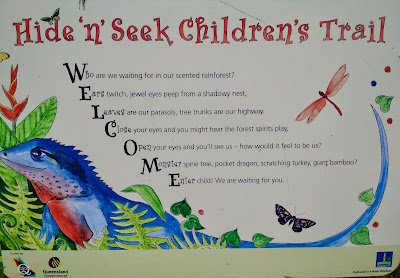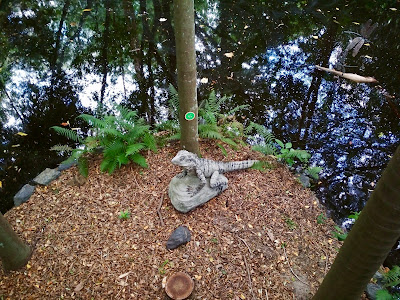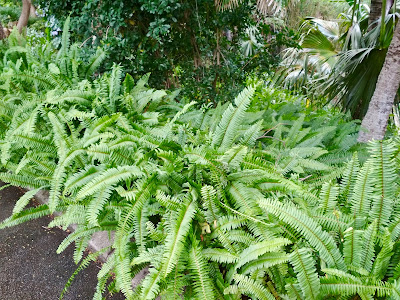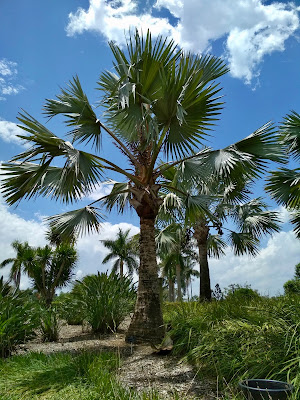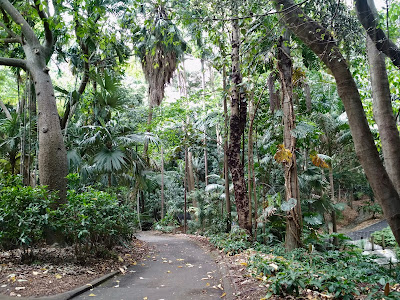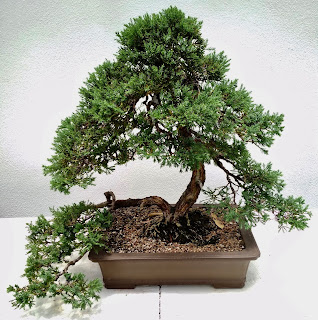Merry Christmas Everyone! I can't believe that it's already here - I was completely focused on our visit to Australia, and it didn't occur to me until much later than I'd like to admit that the holidays were imminent. Anyway, I am three days into a little over two weeks off work, and J has most of that time off as well, and that is a lovely treat. We have a few little things planned, but nothing major, which is exactly what we need.
Back to our Australian adventures - we were lucky enough to be able to visit the Australia Zoo, which is dedicated to Steve Irwin (The Crocodile Hunter) and his family. J is a very big fan, having been inspired by his show and work with animals when he was a kid. So he was delighted to discover that it's not too far outside Brisbane, and we could head there while Doug, Amy, and Sorenne were busy. We were extremely lucky to go on an overcast and therefore cooler day. One of the days we were there was 37C (99F), and I don't think anyone would have enjoyed the zoo very much that day. But the day we went was the coolest of our whole trip, only about 29C (84F), so it was glorious. I think the animals appreciated it too, after such heat.
The first thing we saw were the wombats, which are so cute and cuddly-looking!
They reminded me of Kazul and Roxim, except a thousand times bigger, of course.
This is a Taipan snake, and while I think it's very cool looking, apparently they have nasty tempers, so you really shouldn't try to make friends. (My brother Abe would have me point out that this is a consistent theme in Australia.)
I love the colouring on this snake, called a Woma. Unfortunately, land clearing and burning of its habitat have devastated its population. The Australia Zoo is working to breed them and then release them into protected habitats asap, as the local wild population is close to zero.
This is a blue iguana. While they are cool, I mostly took a picture of it because of the skeptical way it seems to be sizing us up. Also, there is a cute little turtle on the ground under it.
We never did figure out exactly what this bird was called, as it didn't seem to be in any of the pictures in the aviary. But it also gave us a very entertaining look, peering at us from the edge and not moving a muscle until we'd passed on.
This visit was J's first opportunity to meet kangaroos, and he immediately realized that they have a major shared interest, so he joined right in.
They were very good buds, even when awake.
Kangaroos have beautiful eyes, and these ones are so calm and chilled out. It's really lovely to be able to interact with them.
I like the little ones.
We also saw several koalas, relaxing in the trees. I got to hold one during my first visit to Australia about seven years ago, and I'm still fascinated by my discovery that they have three fingers and two thumbs on each hand/foot, for better grip strength. How cool is that?
Being Steve Irwin's passion, crocodiles are central to a lot of what goes on at Australia Zoo. While they are also fans of naps, like J and kangaroos, I'm not sure J has found the best way to bond with this one.
This is an Australian saltwater crocodile, and one of the most dinosaur-y ones we saw. I love the different coloured scales. Not all the Australian saltwater crocodiles we saw had that patterning, so there must be quite a bit of variation.
I know it's hard to see them, but these are Binturongs, a native Australian I'd never even heard of before. They are nocturnal and mostly eat fruit.
Here is a better picture, and when I was looking for a good one on the Internet, I also learned that these little guys smell like buttered popcorn! What?
This is a cassowary, and in case I'd ever wondered whether they were inspiringly/frighteningly prehistoric, this guy helped out by slowly looming his way out of the forest and then glaring up at us. Wow!
Now these Galapagos tortoises are pretty cool, and I have a special affinity for them, having first met them on the Galapagos Islands themselves. However, the star of this show was the little water dragon next to its front foot, who was valiantly trying to get the tortoise's attention (for what purpose I don't know) and kept darting in towards that front foot as the tortoise was walking. Then, when the tortoise stopped, it froze as well, staring up at it. We were immensely entertained.
We found this sculpture of Steve Irwin and his family both beautiful and sad - what a tragedy that he died so young, but how amazing that his family (and many others) are continuing his work.
This is his daughter, Bindi, already a friend to all creatures at such a young age. What an amazing picture of a beautiful moment!
This is a Monitor lizard, and it looks very much like the enormous and very life-like lizard sculpture that lived in our house when I was growing up. I wonder what ever happened to her. Anyway, Monitor lizards are very cool - Australia has a long list of fascinating reptiles.
This is Fang 1, described on her sign as a gorgeous girl with Bette Davis eyes. I love that the zookeepers here love crocodiles as much as Steve Irwin did.
This is Fang 2, who is the mother of Australia Zoo's first ever baby alligators, and her boyfriend Barney, who is apparently very protective of her.
Before we left, we watched a show that was all about celebrating Australia's amazing native wildlife, and especially crocodiles. This was the highlight for me - showing how crocodiles can launch themselves out of the water to grab something hanging down over it. The demonstrations were also about how to be respectful of crocodiles while keeping yourself safe, and I don't think anyone who watched it will be dangling their legs down over the water any time soon.
There were a million more things to see at the zoo, but that's most of what we got to. It wassluch a lovely day, and we learned a lot.

























